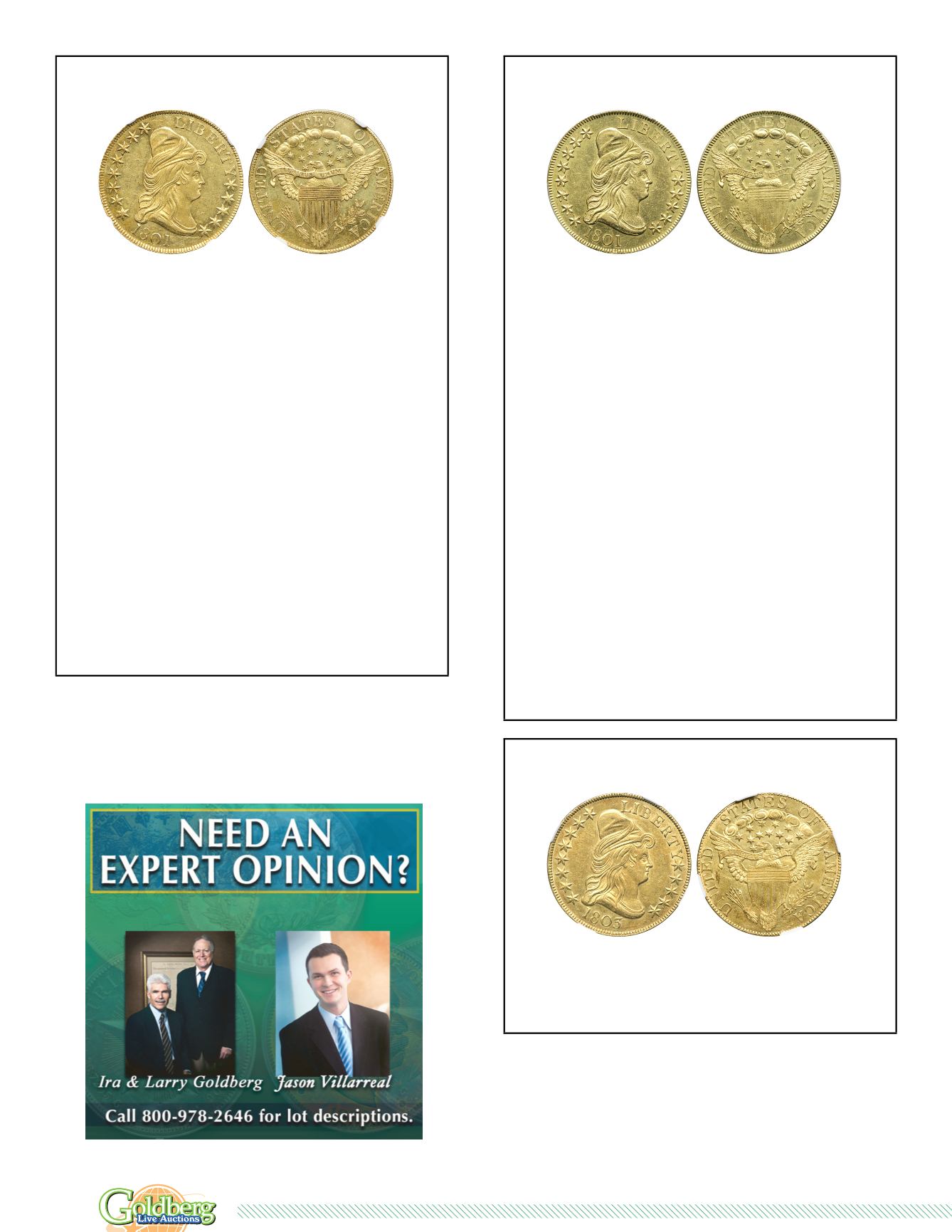
290
|
$10 Gold
M
INT
S
TATE
1801 $10 C
APPED
B
UST
1885
1801 BD-2 Rarity 2
.
NGC graded MS-62
. Well struck
with light golden toning. Nice reflective surfaces. A lock-
solid frosty MS62 with strong primary frost in the devices
offset by prooflike fields, and with attractive golden bright
highlights on both sides. More than adequately struck for
the date, perhaps not 100% so, since this issue rarely is,
but certainly a coin that gets points where fullness of
design is concerned: choice stars and rim, full cap and hair
curls, strong date. On the reverse, we find a very bold
eagle with E PLURIBUS UNUM scroll, much more detailed
stars than average, and excellent clouds. A must-see coin if
you attend lot-viewing, if only for its beauty and historic
significance as the United States’ largest coin denomination
at the time.
The peak of production for the design occurs this year,
when 44,344 1801 capped bust eagles were struck. Two
varieties are known, with one obverse die bearing a Close
Date and another obverse bearing a Wide Date. Although
eagles were delivered well into 1802, that year’s production
is believed to have been from 1801 dies. No 1802 capped
bust eagles exist. As with the sale of other US numismatic
rarities, it is possible that this piece will remain in a tightly
held collection for many years to come.
Pop 61; 74 finer
.
(
PCGS # 8564
)
Estimated Value .................................... $29,000 - 31,000
N
EAR
U
NC
1801 $10 C
APPED
B
UST
1886
1801 BD-1 Rarity 5
.
PCGS graded AU-58
. A nice
untoned example with lots of luster evident. A satiny About
Uncirculated with eye-appeal to match its elevated grade.
Original mint luster graces the light golden surfaces.
Sharply struck for the date, easily finer in sharpness than
many in notionally higher grades. We find the rim dentils
are crisply defined on both obverse and reverse. The sur-
face is smooth, pleasing in its visual impact, and free of
criticism. If one has to point to any diminishment it would
be to several areas on the reverse where the surface has a
slight granularity to it. This is noticeable around the stars
directly over the eagle and in the lower left portion of the
shield and arrows. It could be that the impact from the dies
(these were struck using a manually operated large screw
press at the mint) was insufficient to send all the metal
from the planchet into the die recesses. The resulting minor
roughness is just unstruck planchet surface. All lettering is
crisply detailed. The eagle’s wings feathers complete, the
neck, eye, and beak sharp as well. A full E PLURIBUS UNUM
shows on a sharp-edged scroll.
The peak of production for the design occurs this year,
when 44,344 1801 Capped Bust Eagles were struck. Two
varieties are known, with one obverse die bearing a Close
Date and another obverse bearing a Wide Date. Although
Eagles were delivered well into 1802, that year’s production
is believed to have been from 1801 dies. No 1802 Capped
Bust Eagles exist. (
PCGS # 8564
)
Estimated Value .................................... $20,000 - 23,000
1803 E
XTRA
S
TAR
$10 C
APPED
B
UST
1887
1803. Extra Star BD-5 Rarity 4+
.
NGC graded MS-
60
. A hint of light gold tone with reflective surfaces.
Pop
1; 21 finer
.
Estimated Value .................................... $28,000 - 30,000


